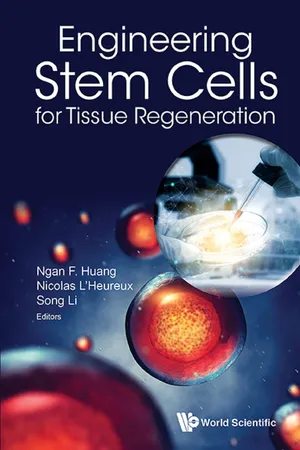
Engineering Stem Cells for Tissue Regeneration
Ngan F Huang, Nicolas L'Heureux;Song Li;;
- 568 pagine
- English
- ePUB (disponibile sull'app)
- Disponibile su iOS e Android
Engineering Stem Cells for Tissue Regeneration
Ngan F Huang, Nicolas L'Heureux;Song Li;;
Informazioni sul libro
-->
Tissue engineering integrates knowledge and tools from biological sciences and engineering for tissue regeneration. A challenge for tissue engineering is to identify appropriate cell sources. The recent advancement of stem cell biology provides enormous opportunities to engineer stem cells for tissue engineering. The impact of stem cell technology on tissue engineering will be revolutionary.
This book covers state-of-the-art knowledge on the potential of stem cells for the regeneration of a wide range of tissues and organs, including cardiovascular, musculoskeletal, neurological and skin tissues. The technology platforms for studying and engineering stem cells, such as hydrogel and biomaterials development, microfluidics system and microscale patterning, are also illustrated. Regulatory challenges and quality control for clinical translation are also detailed. This book provides an comprehensive update on the advancement in the field of stem cells and regenerative medicine, and serves as a valuable resource for both researchers and students.
--> -->
Contents:
- Tissue Engineering: From Basic Biology to Cell-Based Applications (R M Nerem)
- Recent Advances and Future Perspectives on Somatic Cell Reprogramming (K-Y Kim & I-H Park)
- Hematopoietic Stem Cells (J J Trowbridge)
- Mesenchymal Stem Cells for Tissue Regeneration (N F Huang & S Li)
- Delivery Vehicles for Deploying Mesenchymal Stem Cells in Tissue Repair (M S Friedman & J K Leach)
- Stem Cells for Cardiac Tissue Engineering (J L Young et al.)
- Cardiovascular System: Stem Cells in Tissue-Engineered Blood Vessels (R Sawh-Martinez et al.)
- Stem Cells for Vascular Regeneration: An Engineering Approach (L E Dickinson & S Gerecht)
- Stem Cells and Wound Repair (S H Ko et al.)
- Engineering Cartilage: From Materials to Small Molecules (J M Coburn & J H Elisseeff)
- Adult Stem Cells for Articular Cartilage Tissue Engineering (S Saha et al.)
- Stem Cells for Disc Repair (A A Allon et al.)
- Skeletal Tissue Engineering: Progress and Prospects (N J Panetta et al.)
- Clinical Applications of a Stem Cell Based Therapy for Oral Bone Reconstruction (B McAllister & K Haghighat)
- Therapeutic Strategies for Repairing the Injured Spinal Cord Using Stem Cells (M S Beattie & J C Bresnahan)
- Potential of Tissue Engineering and Neural Stem Cells in the Understanding and Treatment of Neurodegenerative Diseases (C Auclair-Daigle & F Berthod)
- High-Throughput Systems for Stem Cell Engineering (D A Brafman et al.)
- Microscale Technologies for Tissue Engineering and Stem Cell Differentiation (J W Nichol et al.)
- Quality Control of Autologous Cell- and Tissue-Based Therapies (N Dusserre et al.)
- Regulatory Challenges for Cell-Based Therapeutics (T McAllister et al.)
--> -->
Readership: Life science scientists; biomedical researchers; cell biologists; academics, postgraduate students and advanced undergraduate students in cell biology, biochemistry and genetics; surgeons; clinicians; biotechnology and pharmaceutical industry professionals.
-->Keywords:Stem Cells;Tissue Engineering;Regenerative Medicine;Biotechnology;Cell EngineeringReview:0
Domande frequenti
Informazioni
1
MESENCHYMAL STEM CELLS FOR TISSUE REGENERATION
1.Introduction
2.MSC Sources and Phenotype
2.1Bone marrow MSCs
2.2Adipose-derived stem cells
3.Differentiation of MSCs in vitro
Indice dei contenuti
- Cover
- Halftitle
- Title
- Copyright
- Preface
- Contents
- Contributors
- Chapter 1 Mesenchymal Stem Cells for Tissue Regeneration
- Chapter 2 Delivery Vehicles for Deploying Mesenchymal Stem Cells in Tissue Repair
- Chapter 3 Stem Cells for Cardiac Tissue Engineering
- Chapter 4 Engineered Mechanical Factors to Mature Pluripotent Stem Cell-Derived Cardiomyocytes
- Chapter 5 Cardiovascular System: Stem Cells in Tissue-Engineered Blood Vessels
- Chapter 6 Stem Cell-Derived Endothelial Cells for Cardiovascular Regeneration
- Chapter 7 Angiogenic Cytokines in the Treatment of Ischemic Heart Disease
- Chapter 8 Adipose Tissue Engineering and Stem Cells
- Chapter 9 Engineering Cartilage: From Materials to Small Molecules
- Chapter 10 Adult Stem Cells for Articular Cartilage Tissue Engineering
- Chapter 11 Stem Cells for Disc Repair
- Chapter 12 Clinical Applications of a Stem Cell-Based Therapy for Oral Bone Reconstruction
- Chapter 13 Potential of Tissue Engineering and Neural Stem Cells in the Understanding and Treatment of Neurodegenerative Diseases
- Chapter 14 Recent Advances and Future Perspectives on Cell Reprogramming
- Chapter 15 High-throughput Systems for Stem Cell Engineering
- Chapter 16 Novel Methods for Characterizing and Sorting Single Stem Cells from Their Tissue Niches
- Chapter 17 Label-Free Microfluidic Techniques to Isolate and Screen Single Stem Cells
- Chapter 18 Microscale Technologies for Tissue Engineering and Stem Cell Differentiation
- Chapter 19 Designing Protein-Engineered Biomaterials for Stem Cell Therapy
- Chapter 20 Quality Control of Autologous Cell- and Tissue-Based Therapies
- Chapter 21 Regulatory Challenges for Cell-Based Therapeutics
- Index